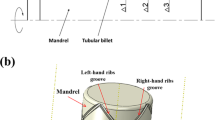Abstract
An analysis method based on minimizing the axial force by the upper bound method was proposed to obtain the optimal attack angle of the roller in the flow forming process. And the method for minimizing axial force was verified effectively by FEM simulation. The axial force of the roller in the flow forming has an essential effect on producing material build-up and bulge ahead of the roller. The optimal attack angle should minimize the axial force of the roller and also avoid defects such as build-up or bulge effectively, improving the manufacturing accuracy and the surface quality of flow formed product. The possible defects like the material buildup and the spring back or the elastic recovery could be numerically simulated by the FEM. It was shown by the elastic-plastic FEM simulations that the attack angle resulting in the least magnitude of the axial force also resulted in the smallest amount of the material build-up. It is concluded that the simplified calculation of the attack angle is practically useful.
Similar content being viewed by others
References
Wong, C. C., Dean, T. A., and Lin, J., “A review of spinning, shear forming and flow forming processes,” Int. J. Mach. Tools Manufact., Vol. 43, pp.1419–1435, 2003.
Ray, G., Yilmaz, D., and Keele, R. P., “Flow Forming, in: Semiatin, S. L. (Ed.), ASM Handbook, Vol. 14A: Metalworking: Bulk Forming,” ASM International, Materials Park, pp. 516–521, 2005.
Mohebbi, M. S. and Akbarzadeh, A., “Experimental study and FEM analysis of redundant strains,” J. Mater. Process. Technol., Vol. 210, pp.389–395, 2010.
Thomsen, E. G., Yang, C. T., and Kobayashi, S., “Spin forging. Mechanics of Plastic Deformation in Metal Processing,” Colliermacmillan Limited, London, pp. 394–414, 1965.
Hayama, M., “Theoretical Study of tube spinning,” Bull. Fac. Eng., Vol. 15, pp. 33–48, 1966.
Hayama, M. and Kudo, H., “Experimental study of tube spinning,” Bull. JSME, Vol. 22, No. 167, pp. 769–775, 1979.
Gur, M. and Tirosh, J., “Plastic flow instability under compressive loading during shear spinning process,” J. Eng. Ind., Vol. 104, pp. 17–22, 1982.
Park, J. W., Kim, Y. H., and Bae, W. B., “Analysis of tube-spinning processes by upper-bound stream-function method,” J. Mater. Process. Technol., Vol. 66, pp. 195–203, 1997.
Kim, N., Machida, S., and Kobayashi, S., “Ring rolling process simulation by the three dimensional finite element method,” Int. J. Mach. Tools Manufact., Vol. 30, pp. 569–577, 1990.
Kim, N., Kobayashi, S., and Altan, T., “Three-dimensional analysis and computer simulation of shape rolling by the finite and slab element method,” Int. J. Mach. Tools Manufact., Vol. 31, pp. 553–563, 1991.
Yea, Y., Ko, Y., Kim, N., and Lee, J., “Prediction of spread, pressure distribution and roll force in ring rolling process using rigid-plastic finite element method,” J. Mater. Process. Technol., Vol. 140, pp. 478–486, 2003.
Kemin, X., Zhen, W., Yan, L., and Li, K., “Elasto-plastic FEM analysis and experimental study of diametral growth in tube spinning,” J. Mater. Process. Technol., Vol. 69, No. 1–3, pp. 172–175, 1997.
Xu, Y., Zhang, S. H., Li, P., Yang, K., Shan, D. B., and Lu, Y., “3D rigid-plastic FEM numerical simulation on tube spinning,” Journal of Materials Processing Technology, Vol. 113, No. 1–3, pp. 710–713, 2001.
Hua, F. A., Yang, Y. S., Zhang, Y. N., Guo, M. H., Guo, D. Y., Tong, W. H., and Hu, Z. Q., “Three-dimensional finite element analysis of tube spinning,” Journal of Materials Processing Technology, Vol. 168, No. 1, pp. 68–74, 2005.
Davidson, M. J., Balasubramanian, K., and Tagore, G. R. N., “Experimental investigation on flow-forming of AA6061 alloy-A Taguchi approach,” Journal of Materials Processing Technology, Vol. 200, No. 1–3, pp. 283–287, 2008.
Roy, M. J., Klassen, R. J., and Wood, J. T., “Evolution of plastic strain during a flow forming process,” J. Mater. Process. Technol., Vol. 209, pp. 1018–1025, 2009.
Rajan, K. M. and Narasimhan, K., “An investigation of the development of defects during flow forming of high strength thin wall steel tubes,” Practical Failure Analysis, Vol. 1, No. 5, pp. 69–76, 2001.
Wong, C. C., Dean, T. A., and Lin, J., “Effects of roller path and geometry on the flow forming of solid cylindrical components,” J. Mater. Process. Technol., Vol. 167, pp. 334–353, 2005.
Ma, Z. E., “Optimal angle of attack in tube spinning,” J. Mater. Process. Technol., Vol. 37, pp. 217–224, 1993.
Hosford, W. F. and Caddell, R. M., “Upper-Bound Analysis. Metal Forming: Mechanics and Metallurgy,” Cambridge University Press, pp. 110–121, 2007.
Alfozan, A. and Gunasekera, J. S., “An upper bound elemental technique approach to the process design of axisymmetric forging by forward and backward simulation,” J. Mater. Process. Technol., Vol. 142, pp. 619–627, 2003.
Kim, N., Kim, H., and Jin, K., “Optimal design to reduce the maximum load in ring rolling process,” Int. J. Precis. Eng. Manuf., Vol. 13, pp. 1821–1828, 2012.
Simo, J. C. and Laursen, T. A., “An Augmented Lagrangian Treatment of Contact Problems Involving Friction,” Computers & Structures, Vol. 42, pp. 97–116, 1990.
Laursen, T. A. and Simo, J. C., “Algorithmic Symmetrization of Coulomb Frictional Problems Using Augmented Lagrangians,” Computer Methods in Applied Mechanics and Engineering, Vol. 108, pp. 133–146, 1993.
Totik, Y., Sadeler, R., Kaymaz, I., and Gavgali, M., “The effect of homogenization treatment on cold deformations of AA2014 and AA6063 alloys,” J. Mater. Process. Technol., Vol. 147, pp. 60–64, 2004.
Author information
Authors and Affiliations
Corresponding author
Rights and permissions
About this article
Cite this article
Kim, N., Kim, H. & Jin, K. Minimizing the axial force and the material build-up in the tube flow forming process. Int. J. Precis. Eng. Manuf. 14, 259–266 (2013). https://doi.org/10.1007/s12541-013-0036-8
Received:
Accepted:
Published:
Issue Date:
DOI: https://doi.org/10.1007/s12541-013-0036-8



